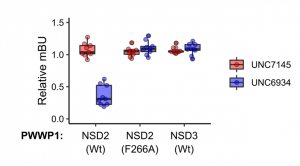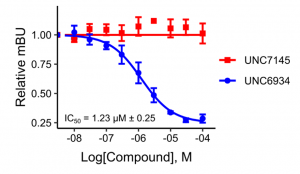Background
NSD2 is a member of the NSD (nuclear receptor SET domain- containing) family of H3K36 methyltransferases which contain a conserved catalytic SET domain and several chromatin-associated domains comprising four PHD fingers, two PWWP domains, and an HMG box. NSD2 is implicated in several diseases including Wolf Hirschhorn syndrome and its overexpression or hyperactivity may cause cancer. The first PWWP domain of NSD2 preferentially binds dimethylated H3K36, which stabilizes NDS2 at chromatin and regulates NSD2 occupancy at its gene targets. PWWP1 does not directly impact NSD2 catalytic activity, however, the increase of cell proliferation caused by NSD2 overexpression is abolished by mutations in the PWWP1 domain affecting its binding to H3K36me2 (PMID:23823660, 26912663, 28054944).
Assay validation
Assay measuring the interaction of NSD2 to histone H3 was developed using NanoBRET technology – a proximity-based assay that can detect protein interactions by measuring energy transfer from a bioluminescent protein donor to a fluorescent protein acceptor. The assay was optimized and validated using NSD2 and H3 antagonist UNC6034 and NSD2-F266A binding deficient mutant. The best results were obtained with U2Os cells transfected with C-terminally NanoLuc-tagged NSD2-PWWP1 and H3 at 1:10 ratio. As shown in Fig 1. chemical probe antagonist (UNC6934) but not its negative control (UNC7145) selectively decreased the BRET signal only in WT NSD2-PWWP1. No effect was observed on F266A binding deficient mutant and closely related NSD3-PWWP1 domain. UNC6934 decreased NSD3-PWWP1 and H3 interaction in a dose-dependent manner (Fig2).

Fig.1. UNC6934 antagonizes interaction between histone H3 and WT NSD2-PWWP1 but not NSD2-PWWP1(F266A) mutant or NSD3-PWWP1 in NanoBRET assay. U2Os cells were co-transfected with C-terminally HaloTag Fusion-tagged histone H3 and C-terminally NanoLuc-tagged NSD2-PWWP1, NSD2-PWWP1(F266A), or NSD3-PWWP1 and treated with 10 µM compounds for 24 h. Shown is the mean ± SD of three biological replicates, run in triplicates. (David Dilworth, Magdalena Szewczyk)

Fig.2. UNC6934 but not negative control compound UNC7145 decrease NSD2-PWWP1 interaction with H3 in a dose-dependent manner. U2Os cells were co-transfected with C-terminally NanoLuc-tagged NSD2-PWWP1 or NSD2-PWWP1(F266A) and C-terminally HaloTag Fusion-tagged histone H3 and treated with compounds for 24 h. Shown is a representative dose-response curve. IC50 was calculated from the mean ± SD of three biological replicates, run in triplicates. (David Dilworth)
The experimental details are posted on Zenodo.
